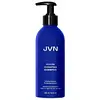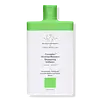What's inside
What's inside
 Benefits
Benefits

 Concerns
Concerns

 Ingredients Side-by-side
Ingredients Side-by-side

Water
Skin ConditioningAloe Barbadensis Leaf Juice
Skin ConditioningSodium Methyl Cocoyl Taurate
CleansingCocamidopropyl Hydroxysultaine
CleansingLauryl Glucoside
CleansingGlyceryl Stearate Se
EmulsifyingCoco-Glucoside
CleansingHydrogenated Farnesene
EmollientSqualane
EmollientGlycerin
HumectantPanthenol
Skin ConditioningPyrus Malus Fruit Extract
Skin ConditioningGlyceryl Oleate
EmollientSorbitan Oleate Decylglucoside Crosspolymer
CleansingGuar Hydroxypropyltrimonium Chloride
Skin ConditioningCitrus Reticulata Peel Oil
MaskingSodium Gluconate
Skin ConditioningSodium Levulinate
Skin ConditioningSodium Chloride
MaskingPotassium Sorbate
PreservativeCitric Acid
BufferingParfum
MaskingHexyl Cinnamal
PerfumingLimonene
PerfumingWater, Aloe Barbadensis Leaf Juice, Sodium Methyl Cocoyl Taurate, Cocamidopropyl Hydroxysultaine, Lauryl Glucoside, Glyceryl Stearate Se, Coco-Glucoside, Hydrogenated Farnesene, Squalane, Glycerin, Panthenol, Pyrus Malus Fruit Extract, Glyceryl Oleate, Sorbitan Oleate Decylglucoside Crosspolymer, Guar Hydroxypropyltrimonium Chloride, Citrus Reticulata Peel Oil, Sodium Gluconate, Sodium Levulinate, Sodium Chloride, Potassium Sorbate, Citric Acid, Parfum, Hexyl Cinnamal, Limonene
Water
Skin ConditioningSodium Lauroyl Methyl Isethionate
CleansingCocamidopropyl Betaine
CleansingSodium Methyl Oleoyl Taurate
CleansingSodium Cocoyl Isethionate
CleansingCoconut Alkanes
EmollientSclerocarya Birrea Seed Oil
HumectantArgania Spinosa Kernel Oil
EmollientPassiflora Edulis Seed Oil
EmollientPlukenetia Volubilis Seed Oil
EmollientPrunus Amygdalus Dulcis Oil
Skin ConditioningRosa Canina Fruit Oil
EmollientGlycerin
HumectantSodium PCA
HumectantCaprylic/Capric Triglyceride
MaskingHelianthus Annuus Seed Oil
EmollientPanthenol
Skin ConditioningGlycol Distearate
EmollientSodium Lactate
BufferingEquisetum Arvense Extract
AstringentPCA
HumectantAlanine
MaskingArginine
MaskingGlycine
BufferingHistidine
HumectantIsoleucine
Skin ConditioningPhenylalanine
MaskingProline
Skin ConditioningSerine
MaskingThreonine
Valine
MaskingAdansonia Digitata Seed Extract
Skin ConditioningTrisodium Ethylenediamine Disuccinate
Prunus Amygdalus Dulcis Seed Extract
Skin ConditioningCitric Acid
BufferingAspartic Acid
MaskingPolyquaternium-10
Polyquaternium-7
Laureth-4
EmulsifyingCoco-Caprylate/Caprate
EmollientCaprylyl Glycol
EmollientSodium Benzoate
MaskingChlorphenesin
AntimicrobialPhenoxyethanol
PreservativeWater, Sodium Lauroyl Methyl Isethionate, Cocamidopropyl Betaine, Sodium Methyl Oleoyl Taurate, Sodium Cocoyl Isethionate, Coconut Alkanes, Sclerocarya Birrea Seed Oil, Argania Spinosa Kernel Oil, Passiflora Edulis Seed Oil, Plukenetia Volubilis Seed Oil, Prunus Amygdalus Dulcis Oil, Rosa Canina Fruit Oil, Glycerin, Sodium PCA, Caprylic/Capric Triglyceride, Helianthus Annuus Seed Oil, Panthenol, Glycol Distearate, Sodium Lactate, Equisetum Arvense Extract, PCA, Alanine, Arginine, Glycine, Histidine, Isoleucine, Phenylalanine, Proline, Serine, Threonine, Valine, Adansonia Digitata Seed Extract, Trisodium Ethylenediamine Disuccinate, Prunus Amygdalus Dulcis Seed Extract, Citric Acid, Aspartic Acid, Polyquaternium-10, Polyquaternium-7, Laureth-4, Coco-Caprylate/Caprate, Caprylyl Glycol, Sodium Benzoate, Chlorphenesin, Phenoxyethanol
Ingredients Explained
These ingredients are found in both products.
Ingredients higher up in an ingredient list are typically present in a larger amount.
Citric Acid is an alpha hydroxy acid (AHA) naturally found in citrus fruits like oranges, lemons, and limes.
Like other AHAs, citric acid can exfoliate skin by breaking down the bonds that hold dead skin cells together. This helps reveal smoother and brighter skin underneath.
However, this exfoliating effect only happens at high concentrations (20%) which can be hard to find in cosmetic products.
Due to this, citric acid is usually included in small amounts as a pH adjuster. This helps keep products slightly more acidic and compatible with skin's natural pH.
In skincare formulas, citric acid can:
While it can provide some skin benefits, research shows lactic acid and glycolic acid are generally more effective and less irritating exfoliants.
Most citric acid used in skincare today is made by fermenting sugars (usually from molasses). This synthetic version is identical to the natural citrus form but easier to stabilize and use in formulations.
Read more about some other popular AHA's here:
Learn more about Citric AcidGlycerin is already naturally found in your skin. It helps moisturize and protect your skin.
A study from 2016 found glycerin to be more effective as a humectant than AHAs and hyaluronic acid.
As a humectant, it helps the skin stay hydrated by pulling moisture to your skin. The low molecular weight of glycerin allows it to pull moisture into the deeper layers of your skin.
Hydrated skin improves your skin barrier; Your skin barrier helps protect against irritants and bacteria.
Glycerin has also been found to have antimicrobial and antiviral properties. Due to these properties, glycerin is often used in wound and burn treatments.
In cosmetics, glycerin is usually derived from plants such as soybean or palm. However, it can also be sourced from animals, such as tallow or animal fat.
This ingredient is organic, colorless, odorless, and non-toxic.
Glycerin is the name for this ingredient in American English. British English uses Glycerol/Glycerine.
Learn more about GlycerinPanthenol is a common ingredient that helps hydrate and soothe the skin. It is found naturally in our skin and hair.
There are two forms of panthenol: D and L.
D-panthenol is also known as dexpanthenol. Most cosmetics use dexpanthenol or a mixture of D and L-panthenol.
Panthenol is famous due to its ability to go deeper into the skin's layers. Using this ingredient has numerous pros (and no cons):
Like hyaluronic acid, panthenol is a humectant. Humectants are able to bind and hold large amounts of water to keep skin hydrated.
This ingredient works well for wound healing. It works by increasing tissue in the wound and helps close open wounds.
Once oxidized, panthenol converts to pantothenic acid. Panthothenic acid is found in all living cells.
This ingredient is also referred to as pro-vitamin B5.
Learn more about PanthenolWater. It's the most common cosmetic ingredient of all. You'll usually see it at the top of ingredient lists, meaning that it makes up the largest part of the product.
So why is it so popular? Water most often acts as a solvent - this means that it helps dissolve other ingredients into the formulation.
You'll also recognize water as that liquid we all need to stay alive. If you see this, drink a glass of water. Stay hydrated!
Learn more about Water